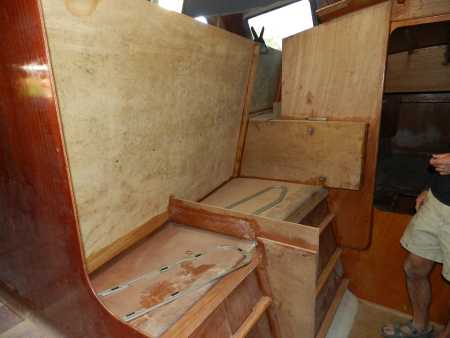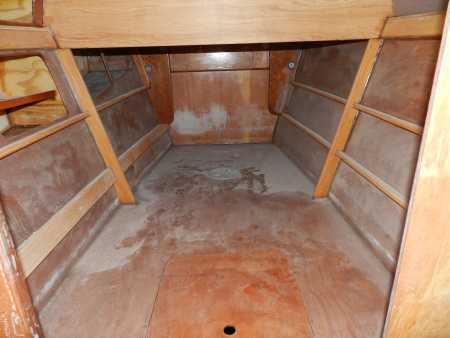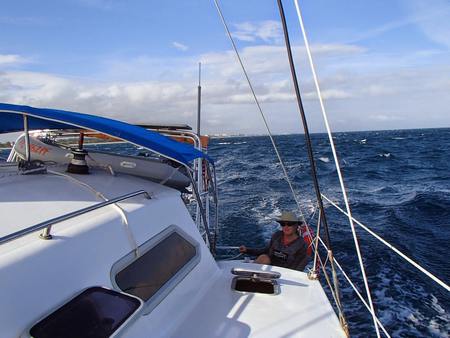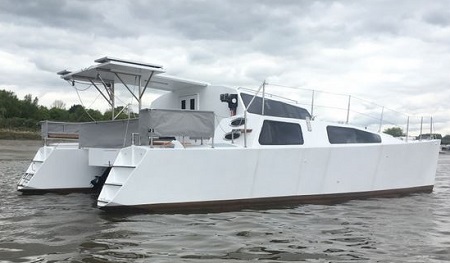All Our Designs

DOWNLOAD PLANS GBP1750.00
Please click on the button below if you wish to buy full building plans. Note: You can pay using Paypal or with your normal credit card.
Plans will be sent as a zip file once payment has been received. This is no longer an automated system, so please allow 48 hours for your order to be processed and your plans emailed to you.
If you have not received plans after that time please contact us at This email address is being protected from spambots. You need JavaScript enabled to view it.. We never transfer money from Paypal until your plans are ready to send out. Normally if there is a delay it is because we are away sailing.
THE FACTS AND FIGURES
hard chine plywood, LAR keels
Vardo Dimensions
LOA 10.4m
LWL 9.9m
Beam OA 6.1m
Weight empty 3T
Weight to WL 4.8T
Headroom hulls 1.9m
Headroom cabin 1.95m
Sail Area 64.4 sqm
Draft 0.9m
Mast length 13.5m
You can download a study plan sheet HERE and view a comprehensive builders blog HERE Please email me for a more detailed studypack


The Vardo, a 34ft cruiser, something between a Romany and Flica. Many people (like myself) don't need the space of a Flica and want better performance. Which is why I like the Romany design. But many less fanatical sailors want an "inside toilet" and basically more comfort.
So this design is a cross between the two boats. The hulls are essentially enlarged Saturn hulls, but with a bit more freeboard. The bridgedeck cabin is Romany styled and a minimum size to get a saloon and space to access the hulls. (a quick note re the name. A Vardo is the Romanii gypsy name for the horse drawn caravan they live in).
Several interior layouts are feasible, providing the main bulkheads are not moved. This one shows the "Owners Cabin" version

I visited Jeff's boat in Dec 2013 and took the photos, below

Wide hull spacing and high bridgedeck clearance starting well back from the bows with a gentle slope to reduce wave slap

Nice wide sidedecks make it safe and easy to walk forward for sail handling or mooring alongside

Amazing to see that the boat was built in such a small, low headroom garage

The port side of the saloon. Seat is long and wide enough to be used as a seaberth if necessary. Lockers and watertanks at forward end

Part of the galley area, with room for an eye-level oven and hob on the inner side, double sink and worktop on the outer hull side. Lots of worktop area and stowage

One of the double bunks, with comfortable sitting headroom
This boat was launched in June 2014, sitting high on its marks.

You can see more here http://sailingcatamarans.blogspot.ca/
The owner later reported "Had the Vardo out today for a great sail. Put the spinnaker up for the first time even though I was singlehanded. A bit odd with the sheeting base so wide looks over trimmed all the time with the clew tacked to the windward bow and the sheet led to the leeward chain plate. It's a spinnaker off a Catalina 30.
It breezed up a bit on the way in and I was certainly in the edge of overpowered. Hit 9 knots on the GPS sailing around 45 deg apparent. Eased off a bit toward the channel and hit 11.5 knots with the tiller pilot steering!"
I sold a set of plans to the Philippines on January 9th 2013 and got this photo (below) on Feb 23rd. Fast work!

The owner of this boat reported about a year later:
"Just an up date on our Vardo.
Our first sea trials with both new main sail and new jib in 15 kts of wind, she handled beautifully. She should sail better when we install the winches, blocks and sail tracks. She is a very comfortable boat and easy to handle. Well balanced and easy to tack. I am impressed at how well she sails, she will turn within her own length even though I extended the keels to 14' with a 12" draft, she draws about 1 meter now. There is a lot of shallow water here.
Thanks for designing a great Catamaran. I would recommend your designs to anyone and appreciate your support! She is a great compromise between performance, comfort and design safety."
Then later he wrote:
Just an up date on the Vardo, she is 99% finished and we sail her at least once a week. We have been doing some Island hopping and sunsets and she sails great! I am so happy with her performance and handling. I have 6" head room and a beautiful Cat............. I could not be happier........!
You must feel good that you have helped to create yacht deigns to give so many people their dreams to live...........
The St Augustine Vardo is now out cruising (two adults and two young children) the builder reported in Jan 2015

"I can now report the Vardo will do 13 knots in full cruising trim with mainsail and small furling jib. We did this a few days back between Stuart and Pompano Beach Fl. While we were steadily surfing in the 9-10 knot range dead down in 20-25 knots a good puff would actually see us break thru the wave ahead into the 12-13 knot range.

When loaded the sterns drag slightly at around 8 knots but when above 10 knots the rig seems to push the bows down and the rudders unload quite a bit with more speed.
Quite good all around. I have a GPS pic of 12.4 but did not have the camera ready for the 13. (Speed shown top right)

On the sail from Ft Lauderdale a Broadblue 345 left about 20 minutes ahead of us. We overtook them within an hour and arrived at the same anchorage an hour or more ahead. I doubt they sailed up the channel the 3 or so miles close hauled either. No doubt they fancied themselves sailing well at 7 or 8 knots. It was also striking how much more motion their boat appeared to have."
And on arriving in the Bahamas he reported "Arrived in Bimini early yesterday afternoon. Did the crossing from Key Biscaynes No Name harbor to Bimini anchor to anchor in 6 hours! A run of roughly 50 NM. When we cleared the Biscayne channel, we could just see 2 boats to the east. It turns out one was "Miss Piggy" a Norseman 500 cat, but we didn't realize what type until we closed with them entering the Bimini channel. We gained roughly 4-5 miles on them on the crossing and had sailed the entire way! Winds had been forecast to be NE at 5-10 which would have been marginal sailing conditions countering the gulf stream, but actual winds ended up being 18-25 knots from the N."
As the Gulf Stream runs north at 2-4 knots most people avoid sailing to the Bahamas in a N wind as it results in somewhat choppy "wind against tide" conditions. Having said that, I have made 8 Gulf stream crossing, all but one in a strong northerly. So that was a good test, not just for the boat, but also for a young family out cruising
Speed under power is always a good guide to the hull resistance, and thus to potential speed under sail. That's because the power is known and so comparisons between two designs are easy. On a forum thread, which was discussing speed under power of the similar Seawind 1000 (but lengthened to 11m) he commented"That's 6.8 knots with two 9.9!?!?? My 11,000 lb 34ft plywood Vardo does 6.5 knots on a single Yamaha 8hp........ "
In early Feb he wrote "Arrived Georgetown yesterday. A front had come thru resulting in 5-6 foot seas straight down the rhumb line, but with wind at about 30 degrees off the seas. Sustained high twenty knots with some gusts to near 35.
With a double reefed main and 80% jib we hit 16.5 knots on just the right combo of wave and wind. More would have been possible with someone trimming the sails when the apparent moved forward and could have at least handled one less reef and the full jib.
My wife said she was wondering where the bolt cutters were, whilst the kids were happily playing in the saloon looking out the windows. I told her this was a proper British sailing cat not a Gunboat!"
In early March he wrote "We won the Georgetown (Bahamas) round the island race in the multihull class and would have won overall but were not scored against the monos this year. Beat all the cats under 46' on elapsed time except for a Crowther 42 with high performance rig and daggerboards. The race was 18 miles with 8 miles of beating in moderate tradewind conditions 16-18 knots 4-5' seas. Could have used more power as I have smallish sails on the boat, but had the boat averaging 7.5 knots tacking within 105 degrees course made good. The Crowther beat us by just 10 minutes over 18 miles and we of course corrected well ahead. Best speed to date is 16.5 knots.

Photo shows us sailing outside in Exuma Sound and also shows one of the two mid 40ish monos we passed on this 8 mile upwind leg. Someone told me a PDQ sailed the race a few years ago in these conditions and they "thought the boat might fall apart". We experienced a few slight slaps on the underwing, but nothing that disturbed our forward progress or Abbys test mug of water on the saloon table!"
"I did paint my waterline 18mm above designers spec, but have never been within 50mm of that with 2 dinghies, 2 kids and full tanks. "
Then in 2016 after crossing to the Bahamas again he wrote "Had the Gulf Stream to ourselves Thursday as all others likely were heeding Chris Parkers warning of 20-30 knot S, SW winds. Perfect sailing weather!"
"My spinnaker is approx 700 sq ft and about 25 years old. The Vardo is faster than a Seawind 1190 with approx 1800 sq ft asymmetrical on a windward leeward course"
See more at Jeff's blog HERE


These photos, above, shows Steves Vardo after launching. He built it outside, no cover, on the UK South coast in only 2 years. Very impressive. You can see a build blog on his Facebook page here https://www.facebook.com/Steves.catamaran/
Basic Materials List
15 sheets 6mm plywood
80 sheets 9mm plywood
12 sheets 12mm plywood
600 board feet 1in x 6in timber (140m of 25mm x 150mm)
3in x 2in 5.7m x 4 (for crossbeams)
2in x 2in5.7m x 5 (for crossbeams)
50 gal (200kgs) epoxy
5lb (2kg) wood flour or similar filler
7000 stainless steel countersunk screws 1in x 6
filler/paint as required
All plywood to be best quality Marine grade Gaboon ply. Sheet sizes are 8' x 4', 2440x1220
All timber to be at least "Joinery Quality". Unless noted otherwise all timber is softwood, eg Douglas Fir, Sitka Spruce, Yellow Cedar or similar. All timber is "PAR", or "Planed all Round". Thus sizes given are nominal, ie 2" x 1" has a finished planed size of approx 45mm x 20mm. (Note: It is usually cheaper to buy wider planks, eg buy 2" x 1" and cut it in half to create 1" x 1").
Epoxy glue is recommended for all glue joints as it is the strongest and most watertight glue.









